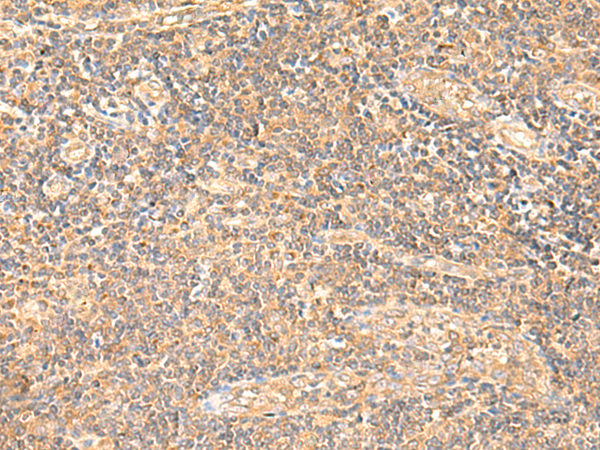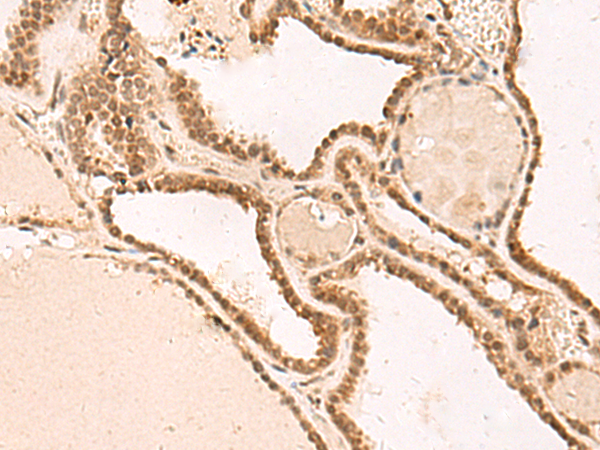


| WB | 咨询技术 | Human,Mouse,Rat |
| IF | 咨询技术 | Human,Mouse,Rat |
| IHC | 1/50-1/300 | Human,Mouse,Rat |
| ICC | 技术咨询 | Human,Mouse,Rat |
| FCM | 咨询技术 | Human,Mouse,Rat |
| Elisa | 1/5000-1/10000 | Human,Mouse,Rat |
| Aliases | TE2; ARD1; NATD; ARD1A; ARD1P; OGDNS; hARD1; DXS707; MCOPS1 |
| WB Predicted band size | 26 kDa |
| Host/Isotype | Rabbit IgG |
| Antibody Type | Primary antibody |
| Storage | Store at 4°C short term. Aliquot and store at -20°C long term. Avoid freeze/thaw cycles. |
| Species Reactivity | Human, Mouse |
| Immunogen | Fusion protein of human NAA10 |
| Formulation | Purified antibody in PBS with 0.05% sodium azide and 50% glycerol. |
+ +
以下是3篇关于NAA10抗体的参考文献及其简要摘要:
1. **"N-alpha-acetyltransferase 10 protein suppresses cancer cell metastasis by binding PIX protein and inhibiting Cdc42/Rac1 activity"**
*作者:Jeon YJ et al. (2019)*
摘要:研究通过Western blot和免疫荧光技术,利用特异性NAA10抗体证实其在抑制癌细胞迁移中的作用,揭示NAA10通过与PIX蛋白互作调控Cdc42/Rac1信号通路。
2. **"ARD1/NAA10 acetylation in prostate cancer suppresses oxidative stress by regulating antioxidant enzyme expression"**
*作者:Wang Z et al. (2020)*
摘要:通过免疫组化(IHC)和免疫印迹分析,发现NAA10在前列腺癌中通过乙酰化修饰调控抗氧化酶表达,抗体实验显示其低表达与患者预后不良相关。
3. **"Naa10p regulates mitotic cell division and apoptosis in hepatocellular carcinoma via acetylating Aurora-A kinase"**
*作者:Li Y et al. (2021)*
摘要:利用NAA10特异性抗体进行染色质免疫沉淀(ChIP)和共聚焦显微镜观察,证明NAA10通过乙酰化Aurora-A激酶影响肝癌细胞有丝分裂和凋亡。
4. **"NAA10 dysfunction causes rare genetic neurodevelopmental disorders through impaired histone H4 acetylation"**
*作者:Casey JP et al. (2022)*
摘要:研究采用患者来源细胞系,通过NAA10抗体进行蛋白质印迹和免疫细胞化学分析,揭示其突变导致组蛋白H4乙酰化缺陷,引发神经发育障碍。
这些研究均涉及NAA10抗体的实验应用(如Western blot、免疫组化、ChIP等),涵盖癌症、表观遗传调控及疾病机制等领域。
The NAA10 antibody is a research tool designed to detect and study the NAA10 protein, also known as N-alpha-acetyltransferase 10 or ARD1. NAA10 is a critical catalytic subunit of the NatA complex, which mediates N-terminal acetylation—a widespread post-translational modification involved in protein stability, localization, and interactions. NAA10 acetylates nascent polypeptides, influencing diverse cellular processes, including cell cycle regulation, apoptosis, and metabolic pathways.
Antibodies against NAA10 are typically generated using immunogenic peptide regions or recombinant protein fragments, enabling applications such as Western blotting, immunohistochemistry (IHC), and immunofluorescence (IF). These antibodies help researchers investigate NAA10 expression patterns across tissues, its subcellular localization (primarily cytoplasmic and nuclear), and dysregulation in diseases.
NAA10 has garnered attention in cancer research due to its dual roles as both a tumor suppressor and oncogene, depending on cellular context and post-translational modifications. Overexpression or mutations in NAA10 are linked to tumor progression, metastasis, and poor prognosis in cancers like breast, lung, and colorectal. Additionally, NAA10 variants are associated with developmental disorders, such as Ogden syndrome.
Validating NAA10 antibodies requires careful optimization, as cross-reactivity with homologous proteins (e.g., NAA15) or isoforms may occur. Their utility extends to mechanistic studies of N-terminal acetylation’s impact on proteostasis and disease, positioning NAA10 antibodies as vital tools in molecular and clinical research.
×